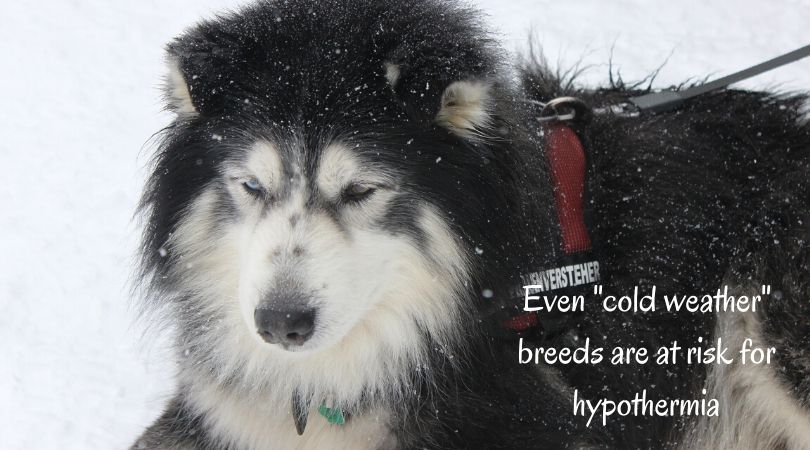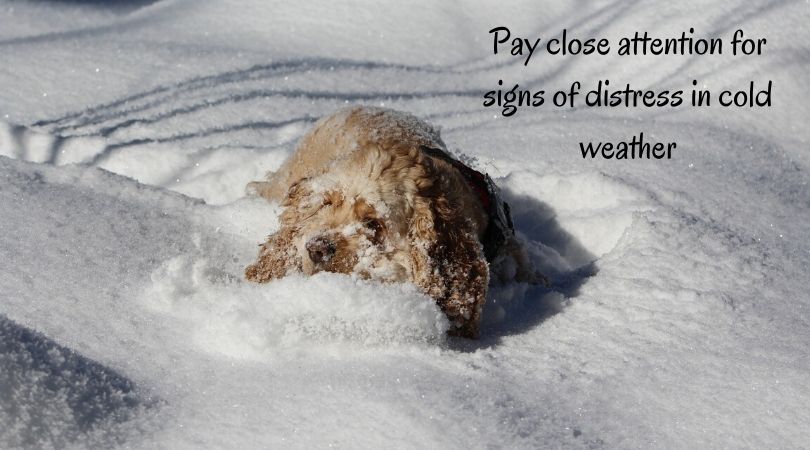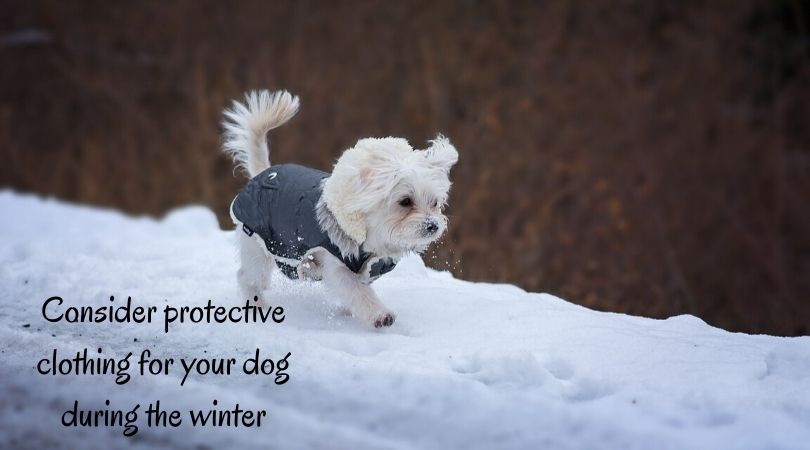Winter is in full swing, and that means colder temperatures, sometimes in the extreme. It can be fun playing in the cool, crisp air (and even snow for some parts of the country!) with your dog, but the cold weather also has some potential health risks to your pup. Just as you have to take precautions for your dog in the extreme summertime heat, you also have to plan accordingly during the extreme cold temperatures that can occur in winter.
Hypothermia is a condition in which your dog’s body temperature falls below the normal level due to prolonged exposure to cold temperatures or from having wet fur in a cold, windy environment. Hypothermia can range from mild to severe. If the dog’s body temperature continues to drop, their heart rate and breathing will slow which can lead to several health problems. This can also lead to frostbite and eventually death.
Being aware of your dog’s behavior, as well as situations that can become dangerous to their health, is the first step to preventing any health risks, such as hypothermia, in frigid weather.
Know Your Dog
By being aware of your dog’s personality and behavior under “normal” conditions, you can better assess how they may be feeling while out in the cold. By knowing their typical energy level, you can better gauge when the cold may be getting a bit much for them. A healthy dog’s normal body temperature is between 100 – 102.5 degrees Fahrenheit. However there are many factors involved that affect a dog’s ability to regulate body temperature, and every dog is different, much like humans. Puppies, elderly dogs, as well as dogs with health issues such as arthritis or heart disease tend to not tolerate the cold weather as well and are more at risk.

Dogs with thin coats are less tolerant of the cold, and smaller dogs are more likely to get wet from snow. On the other hand, larger dogs and those with thick coats may be able to withstand the colder temperatures longer. Certain breeds such as Siberian Huskies and Alaskan Malamutes that are bred to live in colder climates have a higher tolerance for the cold. However, all dogs are at risk, so it’s important to be aware of the signs of hypothermia.
Know the Situation
Especially when temperatures drop to below freezing, that’s the time to be aware and make changes to the normal routine you may have with your pet. You can still go for walks, but you may need to shorten the duration. There are other factors in the weather that may determine what is too cold for your pet. A bitterly cold wind will make the air temperature much colder than what the thermometer reads. Exposure to sleet, freezing rain, and snow greatly increases the potential for frostbite and hypothermia.
Signs and Symptoms
Signs of hypothermia vary depending on the severity. Again, by knowing your dog’s behavior very well, you will have a better chance of noticing the first signs that it might be time to get inside to the warmth.
- Vocalizations – Whining and/or barking are sure signs that your dog is trying to communicate to you that they are distressed or in pain, and it’s time to get inside.
- Shivering – This is an obvious sign that your dog is cold.
- Anxiety or Panic – Some dogs will exhibit signs of anxiety, panic, and fear when they are too cold.
- Decreased Activity – If your dog starts showing a definite sign of slowing down, a decrease in activity, or even stops walking, it is a sign they are cold. This can be confused with just fatigue from exercise, but if you’re in cold temperatures, it’s a sign to get inside.
- Pale Skin and Gums
- Stiffening Posture
- Labored or Shallow Breathing

Severe cases of hypothermia can have the following symptoms:
- Loss of Consciousness
- Fixed and Dilated Pupils
- Coma
In any of these situations, or if you are simply unsure if your dog is in distress, do not hesitate to reach out to us. Hypothermia is an emergency, and no matter what, it is better to be safe than sorry.
Tips for Prevention
The best prevention for hypothermia and other health conditions related to cold weather such as frostbite is to avoid prolonged exposure to the elements.
If it’s cold outside, it’s best to stay outside with your dog so that you can monitor the situation. For one, this will give you an accurate measure of just how cold it is. If you are cold and uncomfortable out there, chances are your dog is, too.
If you must leave them outside alone, be sure to provide a warm, insulated shelter that protects from the wind. The shelter should have warm, dry bedding and if possible, an elevated floor to prevent heat loss. They should always have access to water that isn’t frozen. This means changing it often or purchasing a heated water bowl. If you have to leave them outside, be very conscious of the temperature and do not leave them alone for an extended period of time.
When taking your dog for a walk in extreme cold you may consider using boots. Although canine paws have a high tolerance for cold, boots will add a layer of protection and help keep them warm.

For smaller breed dogs or those with thin coats, a jacket can help provide some added warmth in extremely cold weather.
Again, every dog’s tolerance to cold is different. The most important thing is to monitor your dog and see how they handle it. Take into consideration your dog’s age and health as to how well they may be able to handle the cold temperatures.
As always, if you have any questions or concerns about hypothermia and your dog, please contact your veterinarian.

